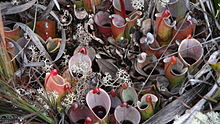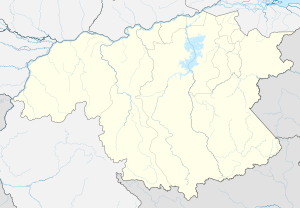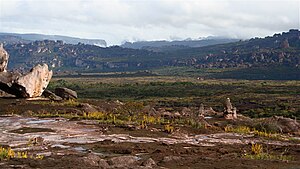Auyan tepui
| Auyan tepui | ||
|---|---|---|
|
The Auyan tepui at dusk |
||
| height | 2450 m | |
| location | Southeast of Venezuela | |
| Mountains | Tepui | |
| Coordinates | 5 ° 48 '15 " N , 62 ° 28' 3" W | |
|
|
||
| Type | Table Mountain , Tepui | |
| rock | Roraima quartzite | |
| Age of the rock | 1.7–2 billion years | |
| First ascent | 1937 | |
|
The bizarre high plateau of the Auyan-Tepui |
||
|
Map of the Auyan-Tepui (2013) |
||
The Auyan-Tepui (from Pemón : Auyan "devil" and Tepui "house") is a table mountain ( Tepui ) up to 2,450 meters high in the south of Venezuela in the Canaima National Park .
Location and dates
There are 97 tepuis in the southern Venezuelan grassy landscape of Gran Sabana , of which the Auyan tepui is the most visited and one of the largest (but not the highest). It rises up to 1,000 meters above the tropical rainforest and the Gran Sabana. The Auyan-Tepui has a summit area of 666.9 km² and an estimated slope area of 795 km².
The high table is a rugged rock labyrinth with canyons, slabs, towers and crevices. The sandstone consists of 95 percent pure Roraima quartzite . This is why the finest white quartz sand is often found in the alluvial troughs. The geologically most impressive phenomenon are the Sima, holes several hundred meters deep in the rock, the origin of which is likely to be caves washed out by the water and then collapsed.
From its eastern flank of the tannin crashes tannin colored teebraun Río Churún as Angel Falls nearly 1,000 meters in depth, forming the highest waterfall on earth.
Flora and fauna

The lack of nutrients on the washed-out tepuis allows only sparse vegetation, which is mainly composed of lichens, grasses, Stegolepis guianensis and Orectanthe sceptrum . Many carnivorous plants such as heliamphores , sundew , water hose , Genlisea , Catopsis and Brocchinia try to compensate for the scarcity with animal protein. In places there are countless orchids. The central areas of the Auyan-Tepui and the valley floors of the canyons are covered by impenetrable forests made up of a few, rather small trees.
The animal world consists of insects , birds , amphibians as well as smaller reptiles (snakes, lizards) and mammals (mice).
Many of the plants and animals on the tepuis are endemic because of the climatic and geological barriers that the rock faces represent . The tepuis are biologically largely isolated islands. Their genetically closest relatives are not to be found in the Gran Sabana 1,000 meters below or in the rainforest on the mountain flanks, but in Africa , which 120 million years ago was still connected to South America as the giant continent of Gondwana .
Emergence
The tepuis are remnants of the Guiana Shield , a quartzite sedimentary rock that is estimated to be at least 1.7 billion years old.
The sedimentary rock does not contain any fossils , since life until the Paleoproterozoic only produced single-celled organisms . Therefore the age of the Tepuis could only be determined with the geophysical method of uranium-lead dating .
history
The tepuis are sacred to the local Pemón Indians, which is why they never attempted to climb them. It was not until the early 1930s that the Venezuela researcher Felix Cardona Puig tried to find a way up the Auyan-Tepui. The expedition discovered the only ascent that is still accessible today for non-mountaineers. In 1937 the American bush pilot Jimmie Angel , his wife and Felix Cardona Puig landed on the high plateau, but suffered a crash landing. They were only able to save themselves thanks to Cardona's knowledge of a route of descent. It was not until 1956 that the first scientific expedition with 40 participants, led by Volkmar Vareschi, climbed the Auyan-Tepui.
Individual evidence
- ↑ Huber, O. (1995). Geographical and physical features. In: PE Berry, BK Holst & K. Yatskievych (eds.) Flora of the Venezuelan Guayana. Volume 1. Introduction. Missouri Botanical Garden Press, St. Louis. pp. 1-61.
literature
- Uwe George: Islands in Time: Venezuela - Expeditions to the last white spots on earth, Hamburg: Gruner and Jahr, 1993, 4th edition, ISBN 3-570-06212-0
- HA Gleason, EP Killip: The flora of mount Auyan-tepui, Venezuela, Brittonia October 1938, Volume 3, Issue 2, pp 141-204 doi : 10.2307 / 2804811





